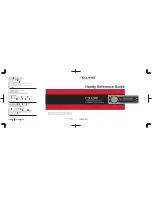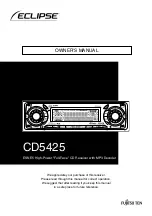
V740 RFID READER/WRITER, ANTENNA
2005-09, REV0.1
OPERATION MANUAL
41 of 56
©OMRON CORPORATION 2005
milliseconds are spent with cursor idle(RF off). This
syntax can be used for controlling the duty cycle of the
reader. For full reader utilization, ensure that the value
of time_out is less than the value of
repeat
, if not the
cursor is executed continuously.
Auto Mode can be terminated by sending the
command:
SET auto = OFF;
No other command can be used while Auto Mode is
active.
To schedule intermittent reads with off times of 1
second starting at a specific time use:
Example:
DECLARE cursor5 CURSOR FOR SELECT id
FROM tag_id WHERE protocol_id='EPC1'
SET time_out=500;
SET auto cursor5 = ON, repeat = 1000;
(get resopnses...)
SET auto = OFF;
To turn off Auto Mode, the SET auto = OFF command
is sent by the client software.
1. If the SET command executes while the cursor is
executing, the cursor will finish before Auto Mode
stops.
2. If the SET command executes while the cursor is
idle, then Auto Mode stops immediately.
Scheduled Reads
The reader uses the Network Time Protocol as a
means to establish absolute time on the reader. With
that capability in place the reader is enabled to
execute tag operations that have been scheduled
relative to absolute time. The reader adjusts UTC time
of the NTP server, whatever time zone it works on.
Here is how it works.
First the user declares a cursor , in a way similar to
how to you use cursors in auto mode.
To run the query once at a specific time you use a
command of the form:
SET trigger_time
cursorname
= '
starttime
';
To run the query in auto mode over a given interval:
SET auto_time
cursorname
= '
starttime
',
repeat=
interval
;
or
SET auto_time
cursorname
=
'
starttime
/
stoptime
', repeat=
interval
;
The first form here starts the auto mode at a given
time, and then just continues until you stop it, the
same way you would stop normal auto mode.
The second form runs during the specified interval.
The start and stop time are specified in ISO8601 time
strings, of the form
YYYY-MM-DDTHH:mm:SS.DDDDZZZZZ
Where YYYY is the year, MM is the month, DD is the
day, HH is the hour, mm is the minute, SS is the
second, and DDDD is the fraction of a second, and
ZZZZZ is the time zone. The seconds and fractions of
a second are both optional (but if you want fractions of
a second, you must specify seconds as well). The
time zone can either be specified as GMT or Zulu time
by using a 'Z' or it can be an offset from GMT using
+HH:MM or -HH:MM. For example, in Eastern time,
that would be -05:00.
Some examples:
C6:
DECLARE cursor6 CURSOR FOR SELECT id
FROM tag_id WHERE antenna_id=1 AND
protocol_id='EPC1';
C7:
DECLARE cursor7 CURSOR FOR SELECT id
FROM tag_id WHERE antenna_id=2 AND
protocol_id='EPC1';
To run c6 once on February 14th 2004 at 18:54:50
GMT:
SET trigger_time cursor6 = '2004-
02-14T18:54:50Z';
To run c7 for 10 seconds starting in intervals of 1000
ms at 2004-01-20 at 15:37 in Eastern Standard Time:
SET auto_time cursor7 = '2004-01-
20T15:37-05:00/2004-01-20T15:37:10-
05:00', repeat=2000;
Note:
If only the start time is specified and the current
time has passed the start time, the cursor is executed
immediately.
If the current time has passed the start time and the
stop time specified in the future, the cursor is
executed immediately and finished at the specified
stop time.
time
DECLARE AUTO ON
RQL execution
Response
repeat
repeat
AUTO OFF
















































